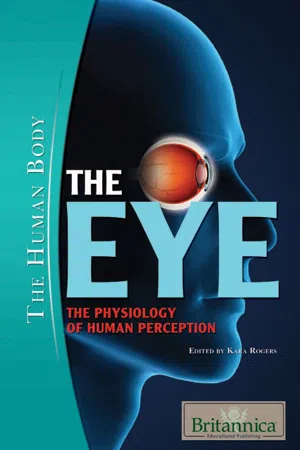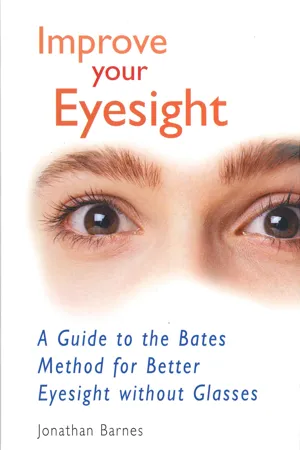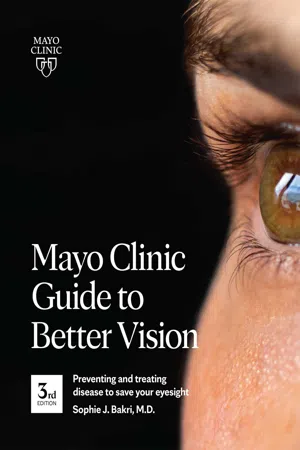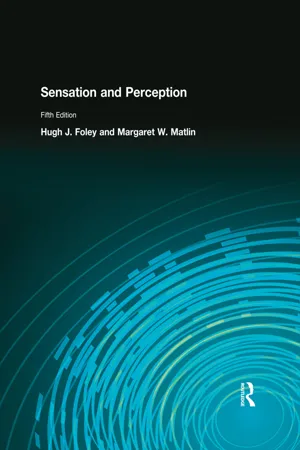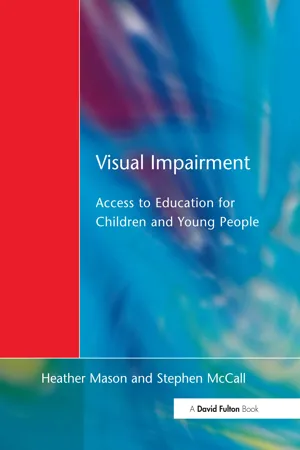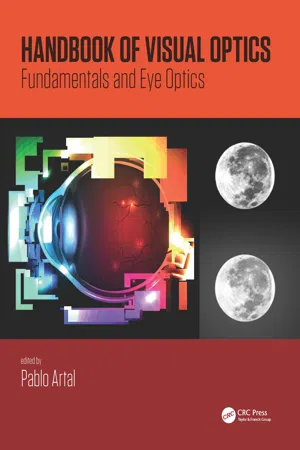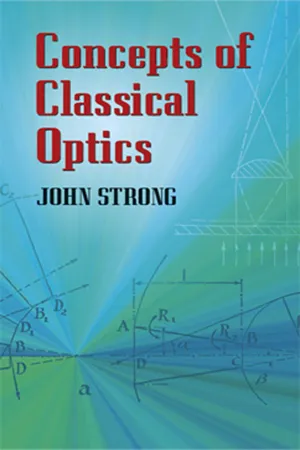Physics
Defects of Vision and Their Correction
Defects of vision refer to conditions such as myopia (nearsightedness) and hyperopia (farsightedness) that affect the eye's ability to focus. These defects can be corrected using lenses, such as concave lenses for myopia and convex lenses for hyperopia. Additionally, corrective procedures like LASIK surgery can also be used to address these vision issues.
Written by Perlego with AI-assistance
Related key terms
Related key terms
1 of 4
Related key terms
1 of 3
10 Key excerpts on "Defects of Vision and Their Correction"
- eBook - ePub
- R.A. Edwards(Author)
- 2014(Publication Date)
- Pergamon(Publisher)
CHAPTER 22The Eye. Defects of Vision and Optical Instruments
Publisher Summary
This chapter focuses on various experimental results related to defects of vision and optical instruments. Image formation, in a good eye, is achieved and perfected by the action of the eye as a whole, namely, cornea, lens, aqueous, and vitreous humors. The angle subtended at the eye lens by the object is the same as that which is subtended by the image at the lens. If the eyeball is of such a length from lens to retina that parallel light from infinity is focused in front of the retina when the ciliary muscles are completely relaxed, short sight, or myopia results. Long sight or hypermetropia is a condition in which the effective power of the eye lens is too small in relation to the length so that when there is no accommodation, parallel light from infinity is focused behind the retina. Presbyopia is the loss of power of accommodation, which is normally associated with the advancing age of an individual. A photographic enlarger is a slightly less elaborate device to the projector. The photographic negative is used in place of a slide and the light-sensitive paper on which the print is to be made takes the place of the screen.22.1 Structure of the Eye
The human eye (Fig. 22.1 ) contains a converging lens L of a gelatinous, transparent material which is not of uniform refractive index throughout and the surfaces of which have different curvatures. The power of the lens is controlled by the ciliary muscles M which act in order to increase the curvature of the lens surfaces. When these muscles are fully relaxed the eye is said to be unaccommodated and it is adjusted for viewing objects at a great distance. When the muscles are fully tensed the eye is fully accommodated for close vision. The point closest to the eye at which an object may be focused clearly when the eye is fully accommodated is called the near point. The distance from the eye of the near point varies considerably from one person to another but is often regarded as being at about 25 cm. The far point is at the greatest distance for which vision is clear when the ciliary muscles are completely relaxed. Ideally this point should be at infinity. The hard, opaque coating of the eyeball, called the sclerotic S , becomes transparent at the front of the eye in order that light may enter. This transparent “window” is called the cornea C . In fact most of the refraction of the light occurs at the cornea, the lens being employed largely for accommodation. Behind the cornea and in front of the lens is the aperture through which light is permitted to enter the lens. This is the pupil P , the size of which is adjusted by a diaphragm called the iris I , which is the familiar coloured part of the eye. The pupil has its largest diameter when illumination is poor, and vice versa. The space A between the lens and the cornea is filled with a salt solution called the aqueous humour . The front of the cornea is also moistened with salt solution and the action of blinking with the eyelids keeps the surface of the cornea clean. The inner wall of the sclerotic at the back of the eye forms the light-sensitive surface R on which the light entering the eye is focused to form images. This surface is called the retina and is covered with light-sensitive cells situated at the ends of nerve fibres which form a network over the surface of the retina and which all leave the the eyeball in a bundle known as the optic nerve O . This leads to the brain which interprets the image on the retina resulting in “sight” or vision. The point at which the optic nerve leaves the eyeball is insensitive to light and is called the blind spot B . In contrast to this is the fovea , or yellow spot Y , at which the retina is most sensitive. This point lies at the intersection of the principal axis of the lens and the retina. The space V between the retina and the lens is filled with a jelly-like substance called the vitreous humour - eBook - ePub
- Britannica Educational Publishing, Kara Rogers(Authors)
- 2010(Publication Date)
- Britannica Educational Publishing(Publisher)
In a normal eye, rays of light from distant objects come to a focus on the retina. In near vision the refractive power of the eye is increased by altering the shape of the lens (i.e., causing it to become thicker) to focus the image on the retina. This ability to alter the shape of the lens decreases with age until fine print cannot be read at a normal reading distance. This condition is known as presbyopia and usually becomes increasingly problematic after age 40. It is corrected by the use of convex lenses for reading.In some eyes, rays of light from distant objects are not brought to a focus on the retina but are focused on a plane in front of the retina, as in myopia (nearsightedness), or behind the retina, as in hyperopia (farsightedness). In myopia, near objects are brought into focus on the retina but distant objects can be seen clearly only with the aid of concave lenses. In hyperopia, distant objects can sometimes be brought into focus by using the accommodative power of the lens, and in young people there is usually sufficient accommodation to enable them to see close up as well. The constant accommodative effort required, however, may result in problems such as asthenopia or esotropia, and the necessity for accommodating for distance can be overcome by wearing convex glasses.Another type of refractive error is astigmatism. In this condition the refractive power of the eye varies in different axes, depending on the path the light takes through the cornea. This is due to the presence of nonuniform corneal curvature and results in the distortion of vision at all viewing distances. Astigmatism is a common condition and can be corrected with the use of cylindrical lenses in eyeglasses or contact lenses.In general, refractive errors are easily corrected with glasses and are rarely accompanied by any serious disease of the eyes. However, hyperopia is a factor in the development of some kinds of strabismus and vision loss (amblyopia) in children, and high degrees of myopia may be associated with serious degenerative changes within the eye, particularly the retina.Presbyopia
The loss of ability to focus the eye sharply on near objects as a result of the decreasing elasticity of the lens of the eye is known as presbyopia. The eye’s ability to focus on near and far objects—the power of accommodation—depends upon two forces, the elasticity of the lens of the eye and the action of the ciliary muscle (a roughly ring-shaped muscle that encircles the lens and is attached to it by suspensory ligaments). When the ciliary muscle is relaxed, the ring enlarges away from the lens and the suspensory ligaments are tautened, flattening the lens into a shape suitable for viewing distant objects. When the muscle contracts, the ligaments are loosened, and, because of the elasticity of the lens, the surface of the lens—particularly the front surface—becomes more curved, in keeping with viewing near objects. Ordinarily the lens gradually becomes less elastic (it hardens) with age, so the power of accommodation is lost progressively. The loss is most rapid after age 40, when most people become aware of difficulty in performing a task, such as reading, that requires near focusing; this can be helped with corrective lenses. - eBook - ePub
Improve Your Eyesight
A Guide to the Bates Method for Better Eyesight without Glasses
- Jonathan Barnes(Author)
- 2011(Publication Date)
- Souvenir Press(Publisher)
Refraction in the eye is carried out not only by the lens, but also, and more importantly, by the cornea, which is strongly curved in cross-section. The lens and cornea work together as a kind of “lens system”.The eyeball is only about 2.5 centimetres (1 inch) in diameter, and if focusing is to be precise this lens system must be free from flaws and very accurately positioned. Should the retina be only fractionally too far away, the focal point of rays from distant objects will fall short, so giving a blurred image. Conversely, if the retina is too close to the lens system (that is, if the eyeball is too short from front to rear), then the focal point of rays from nearby objects will fall, in theory at least, behind the retina, again producing a blurred image.The refractive errors resulting from these two conditions are called myopia (short-sightedness) and hypermetropia (long-sightedness ) respectively.A third type of error, astigmatism, arises when there is a flaw in the shape of the cornea or, more rarely, in the shape of the lens. Unless the cornea is perfectly symmetrical, it will be unequally refractive and rays in differing planes will be brought to differing focal points, producing an image that will be only partly in focus, if at all (Figure 9).Myopia, hypermetropia, and astigmatism can thus all be classed as refractive errors caused by malformation of the eyeball. The fourth common kind of refractive error, presbyopia (also called “old-age” sight and, confusingly, “far-sightedness”), is brought about because over the years the lens slowly loses its elasticity and hence its power to change shape during accommodation. In most people this process begins quite early in adulthood and is completed by the age of about 55 or 60, by which time all flexibility in the lens is lost.Figure 9: The principle of astigmatismIt is unusual for only one of the four common types of refractive error to be present in any given case. Most myopes, for example, have some degree of astigmatism also, and as a myope or a hypermetrope ages his condition is likely to be complicated by advancing presbyopia. - eBook - ePub
Mayo Clinic Guide to Better Vision (3rd Edition)
Preventing and treating disease to save your eyesight
- Sophie J. Bakri(Author)
- 2022(Publication Date)
- Mayo Clinic Press(Publisher)
The intricate process of seeing, with so many complex interactions, can sometimes go wrong. The most common impairments to vision are usually caused by a focusing problem of the cornea or lens or by an abnormal shape of the eye. These problems can often be corrected with eyeglasses, contact lenses or surgery that adjusts the curvature of your cornea.Common vision problems
With normal vision (left), the arrow indicates that the point of focus falls on your retina, providing clear, sharp vision. With nearsightedness (center), the arrow indicates that the point of focus lies in front of your retina, making distant objects appear blurry. With farsightedness (right), the arrow indicates that the point of focus falls behind your retina, making close-up objects appear blurry.You see objects clearly when your cornea and lens focus light rays precisely on your retina (see these illustrations ). If the focusing powers of your cornea and lens aren’t matched perfectly to the length or shape of your eye, however, the point of sharpest focus will fall just short of or behind the retina. When that happens, the image you see is blurred.Nearsightedness
If you’re nearsighted — a condition called myopia — you see close objects clearly but objects farther away are blurry. Nearsightedness commonly occurs when your eye is slightly more elongated than normal. This causes light rays to be focused in front of instead of on the retina.Even with an eye of normal length front to back, you can be nearsighted if your cornea or lens is too steeply curved, bending light rays into focus before they reach the retina. Nearsightedness is often detected during childhood. Signs and symptoms of the condition include:- Persistent squinting
- Sitting very close to a television or movie screen
- Holding books very close to the face while reading
- Seeming unaware of objects or events taking place in the distance
Nearsightedness affects boys and girls equally and it tends to be hereditary. Early on, continued changes may require new corrective lenses more than once a year, but the condition tends to stabilize in the late teen years. - eBook - ePub
Mayo Clinic Family Health Book
The Ultimate Home Medical Reference
- Mayo Clinic(Author)
- 2019(Publication Date)
- Mayo Clinic Press(Publisher)
Minor astigmatism may not cause signs or symptoms. The condition is generally first identified during an eye examination. Astigmatism is treated with a cylindrical corrective lens that corrects for the uneven curvature of the cornea. Hard contact lenses used to correct nearsightedness or farsightedness also correct astigmatism. Another option is surgery to reshape the curvature of the cornea. The procedure is similar to the surgery used to correct nearsightedness and farsightedness.• • • • •Vision Changes With Age
As you get older, your vision changes. If it doesn’t, you’re a rare exception. Many of these changes are primarily an annoyance, and most people learn to adjust.- Often, the retina loses some of its sensitivity to light. To compensate, add brighter lighting to your workstation or your favorite reading chair.
- Lenses in the eye may become less elastic and lose their ability to adjust their focus (presbyopia). You may need reading glasses or a magnifying glass for reading small print.
- Lenses in the eye may become cloudy and cause your visual acuity to decrease, colors to appear dim and glare to form when light shines directly at you (cataract). In this case, you may want to avoid night driving.
- Sometimes, the vitreous humor shrinks, which can produce bothersome floaters in your visual field. With time, most people get used to them. However, if you notice a sudden increase in the number of floaters, you should contact an eye doctor.
Older individuals are also at higher risk of other eye diseases and disorders. Although some vision problems are unavoidable, others can be prevented. And even those that are unavoidable often can be slowed or stopped through early detection and treatment. That’s why it’s important to have your eyes examined frequently.• • • • •Presbyopia
Signs and symptoms
- Nearby objects appear blurry
- Eyestrain, including tired eyes and headache
The term presbyopia - No longer available |Learn more
- Hugh Foley, Margaret Matlin(Authors)
- 2015(Publication Date)
- Psychology Press(Publisher)
Figure 4.18 . Notice how this corrective lens makes the light rays diverge more, so that after passing through the lens of the eye, the rays end up exactly on the retina. The vision of a myopic person, when corrected, resembles the vision of a person with normal vision. Incidentally, the corrective lens is intended to correct vision for distant objects, but vision for nearby objects is also affected. Nearsighted people wearing corrective lenses cannot focus on objects as close to their eyes as they could without corrective lenses. If you are nearsighted and wear glasses or contact lenses, see how close you can bring your finger to your eye and still keep it in focus (your near point), both with and without corrective lenses.Why is myopia a problem for so many people (over 30% of Americans)? One cause of myopia is genetic predisposition (e.g., Hammond et al., 2004). In addition to the hereditary component, several lines of research suggest that myopia is due to experience (Chen et al., 2003; Schwartz, 2004). For instance, the time spent doing close work, such as reading, is correlated with degree of myopia. However, correlation is not necessarily causation, so that evidence alone is not compelling. It would be unethical to study the impact of near work experimentally with humans. Therefore, researchers have turned to animals such as monkeys, tree shrews, and chickens to study thisFigure 4.18 Comparison of visual abilities of normal, nearsighted, and farsighted eyes. For distant objects, the normal eye makes the lens thin, bringing the image into focus on the retina. The nearsighted eye, on the other hand, cannot focus on distant objects. If the lens were to be made thicker, it would just bend the light to a greater extent, causing the image to focus even farther in front of the retina. Instead, an external lens must be placed between the object and the eye. By using the external lens, light can now be brought into focus on the retina. A different problem confronts the farsighted eye. Now the image is brought into focus in back of the retina. The farsighted eye can bring the object into focus by thickening the lens, enabling it to focus on distant objects (hence the term farsighted - eBook - ePub
Visual Impairment
Access to Education for Children and Young People
- Heather Mason, Stephen McCall(Authors)
- 2013(Publication Date)
- David Fulton Publishers(Publisher)
For most children with straightforward refractive errors, their vision will be corrected to normal. Problems will usually only arise if spectacles or contact lenses are not worn for the purpose for which they have been prescribed. Children and young people are considered as visually impaired only when their best corrected vision falls significantly outside the normal ranges for near or distance visual acuity.It is essential that teachers in all areas of the curriculum are aware of when the child should wear glasses; advice should be sought from the optometrist if in any doubt. This information could be written into the Individual Education Plan (IEP) along with other information relating to access to the curriculum.Myopia (shortsightedness)
In normal vision, parallel rays of light coming from a distance should focus on the retina at the fovea — the central point of the macula. If the eye is too long from back to front, as it is in the condition known as ‘myopia’, then the rays of light are focused between the lens and the macula, and this results in blurred distance vision. Spectacles or contact lenses containing concave lenses (minus lenses) can be used to correct this. Near vision is always good provided that the object is brought closer to the eyeball.In most cases of myopia the lengthening of the eyeball is only moderate and becomes static with skeletal growth and correction should be possible to 6/6. However, in a small proportion of myopes the eyeball continues to grow. This condition is known as ‘progressive myopia’ or ‘high myopia’ and normal visual acuity cannot be achieved through the use of spectacles or contact lenses. The stretching of the retina caused by the abnormal growth can affect the efficiency of the macula and may result in holes or rents in the peripheral or central retina. Since there is a risk of a ‘detached’ retina, advice must always be obtained from an ophthalmologist before the child participates in activities such judo or any other ‘contact’ sports, or in aspects of other games such as diving in swimming, or heading a football. - eBook - ePub
- Pablo Artal, Pablo Artal(Authors)
- 2017(Publication Date)
- CRC Press(Publisher)
21 Peripheral aberrations Linda Lundström and Robert RosénContents
21.1 Introduction 21.2 Peripheral optical errors 21.2.1 Oblique astigmatism 21.2.2 Defocus due to field curvature 21.2.3 Coma 21.2.4 Transverse chromatic aberration 21.3 Measuring peripheral optics 21.3.1 Traditional techniques: Subjective refraction and retinoscopy 21.3.2 Foveal refractometers: Additional requirements for peripheral measurements 21.3.3 Lab-based systems 1: The double-pass technique 21.3.4 Lab-based systems 2: Wavefront sensing 21.3.5 Future systems for complete image quality evaluation 21.4 Population data on peripheral optical errors 21.4.1 Refractive errors over the peripheral field and for different types of ametropia 21.4.2 Wavefront aberrations over the peripheral visual field 21.4.3 Image quality over the peripheral visual field 21.4.4 Peripheral variations with age and accommodation 21.5 Effect of peripheral optical errors on vision 21.5.1 Optical effects on peripheral vision 21.5.2 Application 1: Central visual field loss 21.5.3 Application 2: Myopia development References21.1 INTRODUCTIONOur peripheral vision is essential for many daily tasks, such as locomotion and detection. However, the human eye is optimized for central vision, both neurally and optically, and similar to man-made optics, the optical errors of the eye generally increase with incident angle. Peripheral visual function therefore depends on a combination of optical and neural factors. The peripheral visual field is defined as the area in object space that is not imaged to the macula lutea of the eye, that is, typically angles equal to or larger than 7°–10° off the visual axis. The monocular visual field stretches out to around 90° temporally, 60° nasally, 70° inferiorly, and 50° superiorly (Millodot 1997). This chapter starts by presenting the different types of optical errors that are often found in the periphery. An overview will then be given on how the optics can be measured and described as well as population data. The last part of this chapter discusses how these off-axis errors can affect our visual performance. - eBook - ePub
- Janice Gault(Author)
- 2022(Publication Date)
- Elsevier(Publisher)
Fig. 3.3 A, The secondary focal point of a myopic eye is anterior to the retina in the vitreous. B, In hyperopia, the secondary focal point is behind the retina.Source: (From Azar DT, Strauss L: Principles of applied clinical optics. In Albert DM, Jakobiec FA, editors: Principles and practice of ophthalmology, vol 6, ed 2, Philadelphia, 2000, W.B. Saunders, pp 5329–5340.)4. What is the far point of an eye?The term far point is used only for the optical system of an eye. It is the point at which an object must be placed along the optical axis for the light rays to be focused on the retina when the eye is not accommodating.5. Where is the far point for a myopic eye? A hyperopic eye? An emmetropic eye?The far point for a myopic eye is between the cornea and infinity. A hyperopic eye has its far point beyond infinity or behind the eye. An emmetropic eye has light rays focused on the retina when the object is at infinity.6. How do you determine which lens will correct the refractive error of the eye?A lens with its focal point coincident with the far point of the eye allows the light rays from infinity to be focused on the retina. The image at the far point of the eye now becomes the object for the eye.7. What is the near point of an eye?The near point is the point at which an object will be in focus on the retina when the eye is fully accommodating. Moving the object closer will cause it to blur.8. Myopia can be caused in two ways. What are they?- • Refractive myopia is caused by too much refractive power owing to steep corneal curvature or high lens power.
- • Axial myopia is due to an elongated globe. Every millimeter of axial elongation causes about 3 D of myopia.
9. The power of a proper corrective lens is altered by switching from a contact lens to a spectacle lens or vice versa. Why?Moving a minus lens closer to the eye increases effective minus power. Thus, myopes have a weaker minus prescription in their contact lenses than in their glasses. Patients near presbyopia may need reading glasses when using their contacts but can read without a bifocal lens in their glasses (see question 45). Moving a plus lens closer to the eye decreases effective plus power. Thus, hyperopes need a stronger plus prescription for their contact lenses than for their glasses. They may defer bifocals for a while. The same principle applies to patients who slide their glasses down their nose and find that they can read more easily. They are adding plus power. This principle works for both hyperopes and myopes. - eBook - ePub
- John Strong(Author)
- 2012(Publication Date)
- Dover Publications(Publisher)
Chapter XVIImage Defects
WHEN THE angular aperture of a lens is widened, spherical aberration and longitudinal chromatism enter. When the field is widened, the monochromatic aberrations—coma, astigmatism, curvature, and distortion—and lateral chromatism enter. The first defects are defects of aperture; the latter are defects of field. We have discussed some of these aberrations and how the image defects they produce may be reduced or eliminated. We found that spherical aberration of a simple lens was controlled by “bending” it. And we found that certain systems were aplanatic, with both spherical aberration and coma absent. We demonstrated the control of longitudinal chromatism by dividing a lens into two components made from suitably different glasses; or by separating two components made from the same glass. Now, in this chapter, we extend these discussions of image defects.Very few optical systems give images that are free from all defects. Fortunately, certain defects, unimportant in one particular application, can often be tolerated, if the produced images have the specified quality in other respects. Thus, experimentalists can solve optical problems which would be frustrating otherwise. Designers control important defects by the “bending” of components (to minimize aperture defects), or by the position of stops (to minimize field defects), or by the choice of glasses, thicknesses, and spacings for components (to manage chromatism, etc .). Recently, designers have been beginning to use aspheric surfaces more extensively.Mirror components are of course free of chromatism, but the off-axis coma of mirrors may be severe. In a spectrograph, where the camera focuses spectrum lines on a photographic plate, astigmatism is generally unimportant and the photographic plate may be tipped to compensate for longitudinal chromatism. Although a large flat field is of first importance in an ordinary camera, in a monochromator, where the required field is very small, field defects, compared to those of aperture, are of secondary importance. In a photoengraver’s lens freedom from distortion is the most important lens specification. Here chromatism is tolerable because photoengraving can be done with more or less monochromatic light. And, within limits, lack of lens speed in a photoengraver’s lens may be compensated by long exposure. And so it goes; lenses and optical systems are designed or selected according to the specialized functions they must perform.
Index pages curate the most relevant extracts from our library of academic textbooks. They’ve been created using an in-house natural language model (NLM), each adding context and meaning to key research topics.
Explore more topic indexes
Explore more topic indexes
1 of 6
Explore more topic indexes
1 of 4

